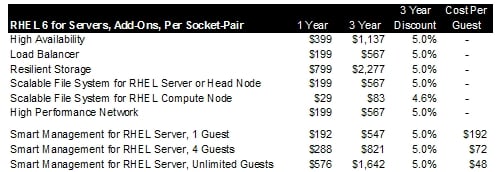This article is more than 1 year old
RHEL 6: how much for your package?
Red Hat price bulge
Virtually unlimited
On the IBM Power platforms, there is no such thing as a basic, entry license, and the RHEL 6 product offers unlimited virtualization in two-socket blocks. The KVM and Xen hypervisors don't work on Power-based systems, and customers use IBM's PowerVM hypervisor to carve up the boxes. The standard license for a Power-based machine is $2,700 for a two-socket block, while a premium license costs $4,300.
Assuming customers are using eight-core Power7 chips and putting virtual machines on each core, the Power version of RHEL costs about 15 per cent more core. Of course, that comparison does not include the cost of the PowerVM hypervisor, which ranges from tens to thousands of dollars per core, depending on the machine.
The pricing for RHEL for IBM's System z mainframes is exactly the same, and one can hardly imagine a price increase being possible at $15,000 per core for a standard contract and $18,000 per core for a premium contract. But remember that IBM's mainframe shops are used to spending much more money than this on their z/OS operating systems. To them, this still feels like a price break.
Red Hat is also selling a special HPC edition for RHEL 6, which is similar in concept to the HPC edition that the company cooked up for RHEL 5 back in October 2008. That HPC edition was $249 per server node, and with RHEL 6, Red Hat has done the smart thing and separated out the functions of a head node in a Linux cluster separately from the compute node functions and charged accordingly. So the head node costs a lot - more than the regular RHEL 6 license in fact, because it has messaging middleware and HPC tunings in it.
We're talking $1,598 for a standard license compared to $799 for the most basic RHEL 6 on a two-socket block. But the compute nodes cost $79, which is cheaper. So say you have a cluster with 64 compute nodes and two head nodes, RHEL 5's HPC edition would have cost $16,434 for standard support. On that same cluster, RHEL 6 HPC edition costs $8,252 - almost precisely half as much. This, by the way, makes RHEL 6 competitive with SUSE Linux among HPC shops, which is the point of that repackaging and repricing exercise with RHEL 6 HPC Edition.
Red Hat has also put together a special version of its Linux for running SAP ERP applications, which costs the same as the premium license for the RHEL 6 Server Edition, but which is tuned specifically for SAP apps and middleware.
That leaves us with the add-ons to the RHEL 6 server, which are outlined here:

Add-On modules for RHEL 6 Server
What used to be called Cluster Suite is now called the High Availability Add-On, and it provides system clustering and failover capability for the Apache Web server, the MySQL and PostgreSQL databases, and SAP applications. The Load Balancer Add-On providers load balancing for Web servers, databases, networks, and storage, while the Resilient Storage Add-On includes the GFS2 clustered file system and a clustered implementation of SAMBA and the Cluster Logical Volume Manager.
GFS2 scales up to 100 TB, which is a lot more than the 16 TB of the default ext4 file system used in RHEL 6. The Scalable File System Add-On is the RHEL 6 module for the XFS clustered file system, and the price varies depending on what kind of server node it is attached to. (XFS also scales to 100 TB). The High Performance Network Add-On includes the RDMA over Ethernet (RoCE) protocol for doing high-bandwidth, low-latency networking on Linux clusters. And finally, the Smart Management Add-On for managing, monitoring, and provisioning RHEL 6 servers though the Red Hat Network or its localized version, Red Hat Network Satellite.
It is important to note that these add-ons are only available for the x64 variants of RHEL 6. Sorry IBM Power and mainframe shops, but you are probably up to your ears in IBM tools anyway. ®
